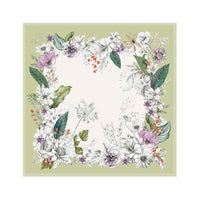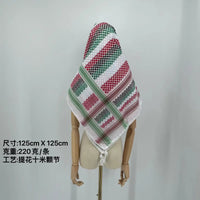Introduction
In a world of ever-changing trends and fast fashion, some garments hold profound meaning beyond mere aesthetics. The Kiffiyeh, a simple yet powerful square of patterned fabric, is one such item. More than just a scarf, it's a powerful symbol of identity, resistance, and heritage, imbued with a rich historical heritage.
From practical use to patriotism: The origin of the Keffiyeh
The story of the keffiyeh didn't start in the world of high fashion. It began in the sun - drenched fields and vast deserts of the Middle East. For centuries, this simple piece of cotton or wool cloth has been an essential part of the daily lives of fellahin (farmers) and nomadic Bedouins. Its main purpose was practical: to protect against the scorching sun, biting winds, and blowing sand in arid lands. This breathable fabric could fend off the hot summer and keep you warm on cool desert nights.

During this uprising against British rule, many Palestinian rebels from rural areas wore keffiyehs to hide their identities. The transformation of the keffiyeh from a practical garment to a powerful political symbol can be traced back to the Arab Revolt in Palestine from 1936 to 1939. In response, the British authorities banned the headscarf, hoping to easily identify and suppress the revolutionaries.

However, the ban backfired. Palestinians - whether from cities or rural areas, rich or poor - started wearing keffiyehs to show collective resistance and unity. The scarf, once a symbol of the peasant class, was now seen by the whole nation as a symbol of unity and resistance against colonial oppression. This historical turning point solidified the keffiyeh's status as a lasting symbol of Palestinian nationalism.
The symbolism in the pattern
The most well - known keffiyeh is black and white, but its design is far from random. Every element of the pattern has profound cultural meaning, telling the story of the Palestinian people's connection to their land and heritage.
Fishing nets:
This repeating mesh pattern pays tribute to Palestinian fishermen in the Mediterranean. It symbolizes the people's deep connection to their coastal roots, as well as the concepts of collective strength and community. Just as a net is made up of many interconnected threads, so is the structure of Palestinian society.
Olive leaves:
Delicate olive leaves are woven along the edges of the fishing - net pattern, symbolizing peace, resilience, and perseverance. The olive tree is the cornerstone of Palestinian agriculture and a powerful symbol of the people's deep - rooted connection to their ancestral land. Despite adversity, the olive tree continues to grow and bear fruit, which is a profound metaphor for the indomitable spirit of the Palestinian people.
Thick lines:
The solid lines running through the pattern are said to symbolize the criss - cross historical trade routes that connect Palestine to the wider world. They represent the region's rich commercial history, cultural exchanges, and its significance as a crossroads of civilizations.
A symbol of unity
While the keffiyeh has long been a symbol of Palestinian identity, its international recognition grew exponentially in the second half of the 20th century, mostly thanks to the late Palestinian leader Yasser Arafat. Arafat's iconic headscarf, artfully draped over his head and shoulders (the pattern was said to resemble the historical map of Palestine), was worn by almost everyone. His frequent appearances on the world stage made the keffiyeh an internationally recognized symbol of the Palestinian struggle for self - determination.
In the following decades, activists and individuals around the world wore keffiyehs as a tangible expression of solidarity with the Palestinian cause. Keffiyehs were everywhere at protests and demonstrations, becoming a silent but powerful symbol of justice and human rights.
More than just a scarf: The versatile and practical ways to wear the Keffiyeh
Beyond its symbolic meaning, the keffiyeh is a versatile and practical accessory. Its large size and breathable fabric make it a valuable addition to any wardrobe.
Classic Keffiyeh:
The traditional keffiyeh offers effective protection against the sun and wind. It can be worn in many ways, each with its own unique cultural charm.
Fashion neckerchief:
Loosely wrapped around the neck, the keffiyeh adds a touch of effortless style to any outfit. It can be worn long, looped, or tied in various knots.
Protective mask:
In dusty or polluted environments, the keffiyeh can be easily pulled up to cover the nose and mouth.
How do you like to style your scarf? Share your favorite looks and techniques in the comments below! We love seeing how our community incorporates these classic pieces into their personal style.
Cultural appreciation of the headscarf
In today's connected world, the line between cultural exchange and cultural appropriation can sometimes get blurry. When wearing the headscarf, it's very important to understand and respect its history and meaning. We encourage you to learn about the stories woven into its patterns and understand the context in which it was created. By wearing the headscarf consciously, you can respect its traditions and connect with the values it represents.












